By Pat Veltri
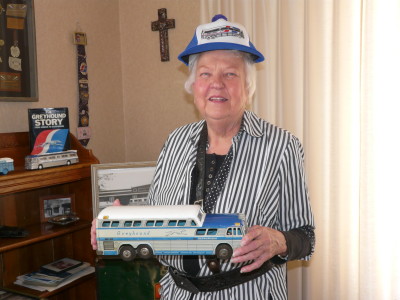
June Unger loves to hunt for treasures from the past at yard sales, estate sales and the local Mercado, as well as thrift stores and antique shops. Her quest for everything that’s old has resulted in the formation of several collections. In the years that we have been associated as members of the Antique Study Group (an organization that she invited me to join), I have come to appreciate her interest in the items she’s collected and the knowledge that she’s acquired. June is what I call an “eclectic collector”, meaning that her collections represent a wide variety of interests. She collects carnival glass, metal trays, hats, ephemera, Fisher-Price pull toys, the art of Norman Rockwell and Greyhound bus memorabilia, the focus of our appointed interview.
When I arrived at June’s home, I was delighted to find a museum-type display of Greyhound bus mementos creatively arranged in a corner of her living room. June describes her memorabilia as “fun and interesting”. As she began discussing her collection, June’s blue eyes lit up and she sported a huge grin. It was obvious by her enthusiasm that June was having fun sharing her personal recollections, which were punctuated by happy peals of laughter, and at the same time she was providing me with some interesting bits of information.
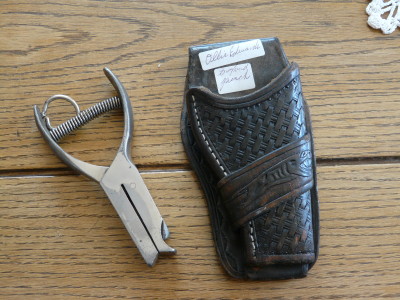
The Greyhound memorabilia is not merely a collection, but is representative of Raton’s bus transportation history in the prime years. June didn’t acquire these historical bits and pieces in the usual way, by purchasing them at yard sales, estate sales or antique stores, but instead was entrusted with them by family members of a couple of local Greyhound drivers, Harold Harris and Ollie (Blackie) Edwards. A significant portion of her collection is comprised of keepsakes from her husband Chuck, who was a Greyhound driver for 34 years. Most of the items in June’s collection highlight the bus driver and his accoutrements – belt, tie, identification card, ticket punch, operator’s manual, safety awards, service pins and watches, uniform buttons, and log book. Also included are books, photos, toys, pictures and news articles. The collection becomes memorable and is enhanced by June’s special memories and the firsthand knowledge she has acquired as the spouse of a bus driver.
A neat personal appearance was a requisite of drivers for the Greyhound Corporation. June explains, “The drivers had to have their hair cut real nice and they always wore the Greyhound uniform, and they had to have their shoes polished”. She adds, “The driver always wore his jacket and hat while loading and unloading passengers.” The uniform ensemble included gray pants and shirt, a blue tie, black shoes, a black belt and hat. Ticket punches were usually worn on the belt.
Greyhound Lines advertised “leave the driving to us” and their bus drivers were noted for their defensive driving, their reliability and their courtesy. Potential bus drivers were required to attend a three-week training session in Dallas, Texas, which included two weeks of classroom instruction and one week of driving practice. June’s husband Charles started his job with the Greyhound Corporation in May 1955. She says, “He had to go to school for three weeks, and then he had to drive for a certain length of time with another driver. Greyhound was really pretty strict about safety and everything like that.”
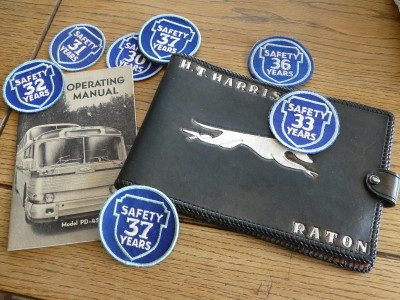
It was mandatory for all bus drivers to keep a record of miles logged. She recalls, “Chuck would spend at least 15 or 20 minutes after he’d get home from a trip filling out that log, recording the mileage.”
June remembers that “people looked up to the Greyhound drivers” and were generally grateful for having the excellent services and courtesies extended to them by the drivers. She says, “They were very helpful, especially with children traveling alone. They would help them all they could and kind of look after them on the bus and at rest stops.” A case in point was the time that her husband was working a night run and brought home a Boy Scout. “Chuck didn’t want to leave him down there at the bus depot so he brought him home, and he stayed the night with us. We heard from him every Christmas for years and years,” says June.
However, there were times when even the most courteous bus driver was called to test. June laughingly recalls a time when an irate passenger wrote a letter to bus officials and referred to her husband as a “Gestapo” because he refused to allow the passenger to smoke a cigar. Smoking cigars was not allowed on the buses.
Package express was an important service offered to the public by the Greyhound Company and its drivers. June says, “They had a lot of package express. They delivered flowers all over and different perishable things. They used to haul a lot of drugs to different doctors, and they delivered newspapers from Albuquerque and Denver.” Local people often asked June’s husband to deliver packages to their college students.
An important item of interest in the collection is a Seniority Roster of Operators, dated June 15, 1966 that included the names of the following drivers from Raton: Harold Harris, Buford Glenn, Dillard Bishop, Frank Gott, Tracy Stuart, Sr., William Plymale, Herman Prater, William Carroll, Charles Unger, William Allen, Leonard Davidson, Guy Abel, Buddy Baker, Clarence Budd, Fred Munden, Howard Suttle, Ollie (Blackie) Edwards, George Drebing, Frank Redlich and George McGuire. On this roster Harold Harris was number one in seniority among drivers throughout the United States, having started as a driver on April 9, 1930.
One of Raton’s drivers, Howard Suttle, distinguished himself as an artist and writer. After his retirement, he wrote and illustrated a book entitled Behind the Wheel…On Route 66 that detailed his 28 years of driving experiences. His book is included in June’s collection. According to June, Howard Suttle specialized in painting portraits of Raton’s leading citizens. One example is the portrait of Jim Pappas, founder of Pappas’ Sweet Shop Restaurant, which is displayed in the restaurant’s dining room.

June’s favorite piece is Harold Harris’ trunk, labeled with the Pickwick-Greyhound logo. “You just look at it and it’s dented in places and kind of heavy. You just know it’s been really been in and out of a lot of places,” June states.
The Pickwick-Greyhound emblem is represented on most of the items that June received from the Harris family. One of the oldest mementos is a 1930 photo depicting Pickwick-Greyhound buses in front of a Denver terminal. According to a 1969 Empire Magazine article in June’s collection, the first Pickwick Stage Line “Nite Coach” from California rolled through Denver on a test run to Kansas City in 1928. It was a double-decker sleeper bus with sleeping accommodations for 26 passengers. It had upper and lower berths, dining service, hot and cold water, bathrooms and other conveniences. When Pickwick merged with Minnesota based Northland-Greyhound Transportation in 1929, the company became known as Pickwick-Greyhound.
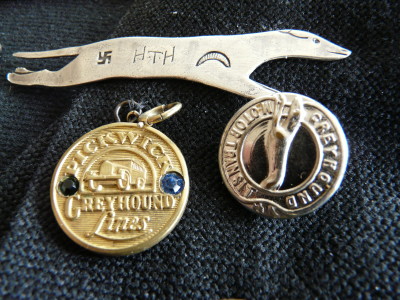
Greyhound Lines, the largest intercity carrier of passengers by bus in North America, was founded in Hibbing, Minnesota in 1914, and incorporated as the Greyhound Corporation in 1926. Its name and logo are based on the Greyhound, the fastest breed of dog in dog racing. One final comment from June: “There’s probably been at least one (Greyhound) bus through Raton every day since about 1930.” The heyday of bus transportation through Raton was from the 1920s to the late 1960s and the memories of those times live on through June Unger, collector and curator of Greyhound memorabilia. Thanks, June for a “fun and interesting” interview!
~~~~~~~~~~~~~~~~~~~~~~~~~~~~~~~~~~~~~~~~~~~~~~~~~~~~~~~~~~~~~~~~~~
HISTORY TIDBITS: BUS TRANSPORTATION 1930-1968
Compiled from Raton’s Newspaper Archives
- An article in The Raton Evening Gazette, dated November 14, 1930, released information that Raton would “shortly have a modern bus depot”. All of the bus lines running into the city, including the Pickwick Stages, the Atlantic and Pacific Stages, the Safety First Bus Company of Amarillo, and the Raton-Taos Stages, would use the station as a terminal. Previously, passengers from different lines were dropped in different parts of town.
The depot would be located on the north corner of South Second Street and Clark Avenue. The Gazette reported that a ticket sales room together with a waiting room would be connected, through a large doorway, to the Silver Moon Café to form the depot.
According to The Gazette, “the depot will answer a long needed want.” There was a large volume of bus passengers passing through Raton and changing busses at Raton, and “heretofore, passengers have been dumped on the streets to wait around on the streets for the next bus”.
Proprietors of the Silver Moon Café provided the funds to build the depot.
- With the completion of the new Union Bus Depot building in 1938 (present location of the Phil Long Ford showroom), Raton became the divisional headquarters of Southwestern Greyhound Lines, transferring the division point from Trinidad, Colorado. J.T. Bauman, division manager, and about 20 other employees moved their families from Trinidad to Raton. Personnel from the Trinidad office took over the new terminal on April 1, 1938.
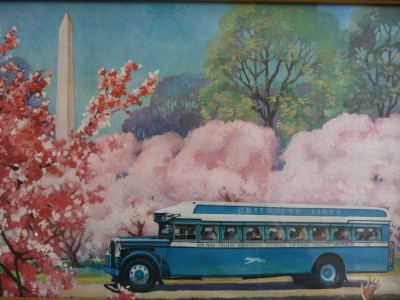
The official opening of the depot was on April 13, 1938. According to an account of the open house in The Raton Daily Range, a Greyhound official, R.A. Kennedy, described the building as “one of the ‘latest’ and ‘best’ depots the company had”. The Range reported that about 1000 Ratonians “jammed the new Greyhound bus terminal to admire, dance and hear speeches”.
Kilbourne L. House, an Albuquerque contractor, constructed the Spanish style building, which came with a $50,000 price tag for the construction and furnishings. Raton’s WPA workers poured the cement for the new sidewalks in front of the building.
The new building, considered one of the finest in the Southwest, boasted many amenities including an inter-room communication system that notified passengers of the arrival and departure of buses and a Westinghouse “cooled” water fountain. It encompassed a waiting room, company offices, a coffee shop and a large garage with a trained force of mechanics on duty to service the buses around the clock.
- On the evening of May 1, 1945, fire broke out in the back end of the huge bus depot. More than 100 passengers and employees were in the building at the time. The May 2nd edition of The Range reported that the fire was probably “caused by the gasoline tanks on the buses and perhaps the huge tires as well”. According to The Range damage was terrific. Two Greyhound buses, valued by officials at $20,000 each, were a major loss. Local Greyhound officials estimated that damage to the building would run into thousands of dollars despite the fact that the front of the building received little damage. The Range stated, “All of the roof over the rear half of the building fell in, much damage was done in the rear and side walls and all maintenance equipment in the shop department was lost.” A Greyhound service employee, Paul Ashford, who was servicing a bus at the time suffered serious burns on his hands and legs.
A temporary bus station was set up at the Silver Moon Café. Joe DiLisio, one of the owners of the building, told The Range that “insurance would be adequate to cover the entire loss to the building”.
- Under the headline MORNING CHOW FOR 1100 GI’S GOES SMOOTHLY (December 17, 1966) The Range described how John and Aleene Monroe, owners of the bus depot restaurant, and Bob Hood, owner of the Robin Hood Restaurant, successfully handled feeding the American soldiers, homebound for the Christmas holidays. Among the busloads of soldiers were 20 men from Raton.
According to The Range the first of 29 buses of soldiers arrived shortly before 3:00 a.m. None of the buses were held up more than a half hour while the soldiers were being served and it took six hours to feed all of them Most of the soldiers were basic trainees from Fort Bliss, an El Paso, Texas army base.
Union Bus Depot had twelve restaurant staff members working during the early hours of Saturday, December 17. The Range’s inventory of the food stockpiled at the two restaurants showed “a total of 200 pounds of sausage, bacon and ham, 160 loaves of bread, more than 2000 eggs and coffee for several hundred gallons”.

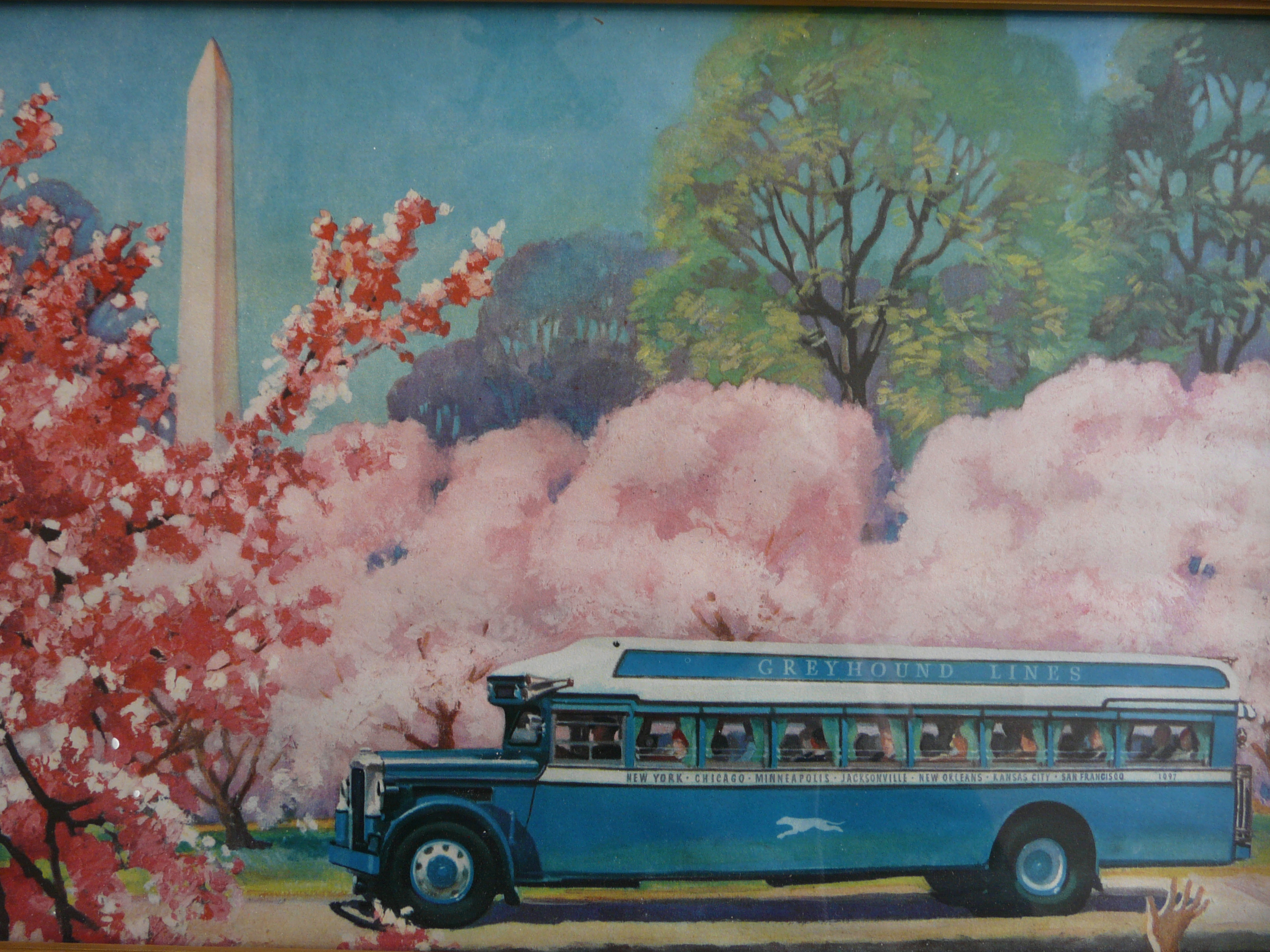
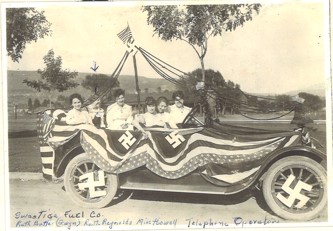



Loved reading about June and her collection. So many of the drivers names I recognized as we had a
connection either with them or their wives…..fun to recall memories.